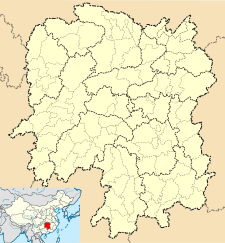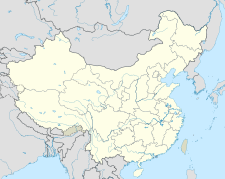Xuandu Temple
| Xuandu Temple | |
|---|---|
玄都观 | |
 The shanmen of Xuandu Temple | |
| Religion | |
| Affiliation | Taoism |
| Prefecture | Hengshan County |
| Province | Hunan |
| Deity | Three Pure Ones |
| Location | |
| Country | China |
| Prefecture | Hengshan County |
| Geographic coordinates | 27°16′27.22″N 112°42′06.36″E / 27.2742278°N 112.7017667°E |
| Architecture | |
| Style | Chinese architecture |
| Founder | Tan Jiaoqing (谭教清) |
| Date established | 1862–1874 |
The Xuandu Temple (simplified Chinese: 玄都观; traditional Chinese: 玄都觀; pinyin: Xuándū Guàn) is a Taoist temple located on the hillside of Mount Heng, in Hengshan County, Hunan, China.[1][2] It is the site of Hunan Taoist Association.
History
[edit]The Xuandu Temple was first established in the Tongzhi period (1862-1874) of Qing dynasty (1644–1911) by Taoist priest Tan Jiaoqing (谭教清). It formerly known as a Buddhist temple named Xiyun'an (吸云庵), which was built in the Southern Qi dynasty (479–502).
On November 3, 1985, the Hunan Taoist Association was set up here.[3]
Architecture
[edit]The temple consists of more than 5 buildings, including shanmen, HalI of the God of Wealth, Hall of Medicine King, Main Hall, and Sanqing Hall (Hall of Three Pure Ones).[3]
Main Hall
[edit]The Main Hall is the second hall in the temple for the worship of the Jade Emperor.[3]
Sanqing Hall
[edit]The Sanqing Hall or Hall of Three Pure Ones is the third hall in the temple. In the middle is Yuanshi Tianzun, statues of Daode Tianzun and Lingbao Tianzun stand on the left and right sides.[3]
References
[edit]- ^ 湖南省南岳衡山玄都观举行冠巾法会. daoisms.org (in Chinese). 2017-10-22.
- ^ Hu Jun (2013-03-27). 衡阳南岳区道教协会举行首届纪念老子诞辰祈福法会. rednet.cn (in Chinese). Archived from the original on 2018-02-28. Retrieved 2018-02-28.
- ^ a b c d 玄都观 [Xuandu Temple]. nanyue.net.cn (in Chinese). 2014-04-30.


